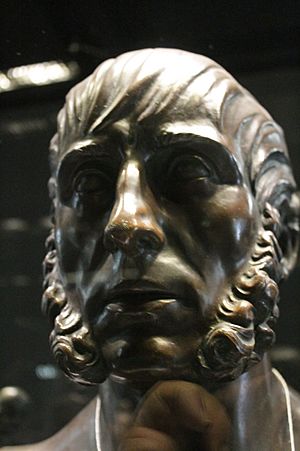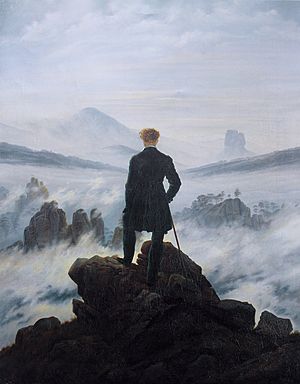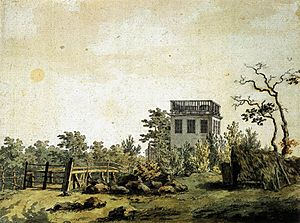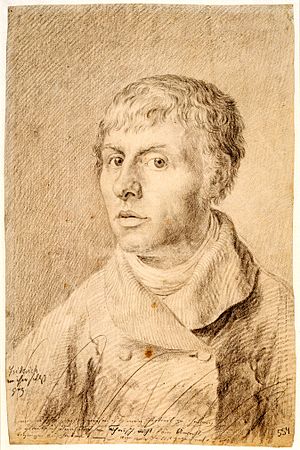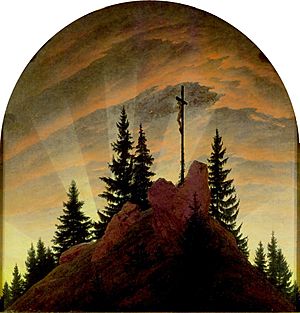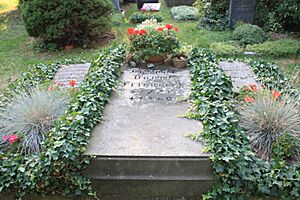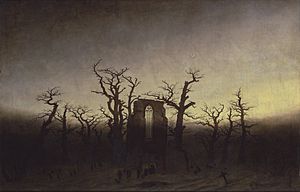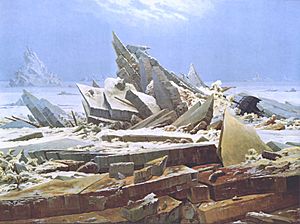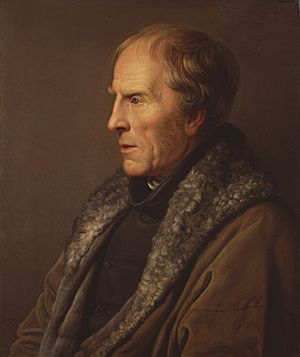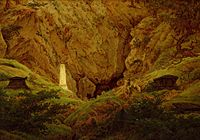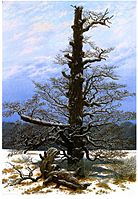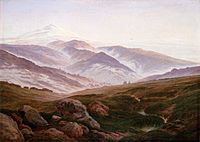Caspar David Friedrich facts for kids
Quick facts for kids
Caspar David Friedrich
|
|
|---|---|

Gerhard von Kügelgen, Caspar David Friedrich, c. 1808, Hamburger Kunsthalle
|
|
| Born | 5 September 1774 Greifswald, Swedish Pomerania
|
| Died | 7 May 1840 (aged 65) |
| Nationality | German |
| Known for | Painting |
|
Notable work
|
|
| Movement | Romanticism |
Caspar David Friedrich (born September 5, 1774 – died May 7, 1840) was a very important German painter. He lived during the 19th century and is known as a Romantic landscape artist. He is famous for his paintings that show deep feelings and ideas through nature.
His artworks often show people looking at beautiful or dramatic scenes. These scenes include night skies, misty mornings, bare trees, or old Gothic ruins. Friedrich loved to think about nature and how it connects to our feelings. His paintings often show tiny human figures in huge landscapes. This makes you feel how small we are compared to the vastness of nature.
Friedrich was born in Greifswald, a town by the Baltic Sea in what was then Swedish Pomerania. He studied art in Copenhagen until 1798. After that, he moved to Dresden, where he lived for the rest of his life. He grew up when many people in Europe started to care more about spiritual things. They began to see nature as a "divine creation," something special and holy.
Friedrich became famous early in his career. People like the French sculptor David d'Angers said he showed the "tragedy of landscape." But later in his life, his art became less popular. He died without much recognition. In the late 1800s, Germany was changing fast, and Friedrich's quiet paintings seemed old-fashioned.
However, in the early 1900s, people started to appreciate his work again. An exhibition in Berlin in 1906 helped bring his art back into view. Artists like the Expressionists and Surrealists found inspiration in his paintings. Later, some people linked his art to Nazism, which made his popularity drop again. But by the late 1970s, Friedrich was finally seen as a major artist of the German Romantic movement.
Contents
Life Story
Growing Up and Family Life
Caspar David Friedrich was born on September 5, 1774, in Greifswald, Germany. He was the sixth of ten children. His family followed a strict Lutheran faith. His father made candles and soap. The family's money situation is not clear. Some say they had private teachers, while others say they were quite poor.
Friedrich experienced a lot of sadness and loss when he was young. His mother died when he was seven. A year later, his sister Elisabeth passed away. Another sister, Maria, died in 1791 from typhus. The biggest tragedy happened in 1787. His younger brother, Johann Christoffer, drowned in a frozen lake. Some stories say Johann Christoffer was trying to save Caspar David, who was also in danger on the ice.
Friedrich started his art studies in 1790. He was a private student of Johann Gottfried Quistorp at the University of Greifswald. Quistorp took his students outside to draw from nature. This helped Friedrich learn to sketch real-life scenes early on. Through Quistorp, Friedrich met Ludwig Gotthard Kosegarten, who taught that nature showed God's presence. Quistorp also introduced Friedrich to the work of Adam Elsheimer, an artist who often painted religious scenes in landscapes, especially at night.
Four years later, Friedrich went to the famous Academy of Copenhagen. There, he copied old sculptures and drew from real models. In Copenhagen, he could see 17th-century Dutch landscape paintings. His teachers, like Jens Juel, were inspired by the Sturm und Drang movement. This movement focused on strong emotions and dramatic feelings in art.
Moving to Dresden
Friedrich moved to Dresden for good in 1798. At first, he tried making prints like etchings and woodcuts. By 1804, he had made 18 etchings and four woodcuts. He mostly gave these to his friends. Even though he tried other art forms, he mainly worked with ink, watercolours, and sepia drawings. He didn't start painting much with oils until he became more well-known.
Landscapes were his favorite subject. He often traveled to the Baltic coast, Bohemia, and the Harz Mountains to find inspiration. His paintings show forests, hills, harbors, and misty mornings. He carefully observed how light looked on clouds and water. He drew sketches of places like the cliffs on Rügen and the Elbe river. He used these sketches to create his detailed paintings from memory.
Friedrich became famous when he won a prize in 1805. This was at a competition in Weimar, organized by the writer Johann Wolfgang von Goethe. Goethe was very impressed by Friedrich's two sepia drawings. He praised Friedrich's skill and clever ideas.
In 1808, Friedrich finished his first major oil painting, Cross in the Mountains. This painting is also called the Tetschen Altar. It was made for a family chapel in Tetschen. The painting shows a cross on top of a mountain, surrounded by pine trees. It was controversial because it was the first time a landscape was used as an altarpiece in Christian art.
Many people didn't like the altarpiece at first. An art critic named Basilius von Ramdohr said it was wrong to use a landscape in a religious painting. Friedrich explained his painting in 1809. He said the evening sun's rays were like the light of God. This was one of the few times Friedrich explained his own artwork in detail.
In 1810, the Prussian Crown Prince bought two of his paintings. Because of this, Friedrich was made a member of the Berlin Academy. In 1816, he became a citizen of Saxony. He hoped to become a full professor at the Saxon Academy. But he never did, because people thought his art was too personal to teach others. Also, his German-themed paintings sometimes clashed with the pro-French feelings of the time.
Marriage and Later Life
On January 21, 1818, Friedrich married Caroline Bommer. She was 25 years old. They had three children. Their first child, Emma, was born in 1820. Friends said that marriage didn't change Friedrich much. However, his paintings from this time, like Chalk Cliffs on Rügen, look brighter and happier. More people started appearing in his paintings, showing that his family and friends were becoming more important to him.
Around this time, he got support from Russia. In 1820, Grand Duke Nikolai Pavlovich visited Friedrich's studio. He bought several paintings and took them to Saint Petersburg. This started a long period of support from the Russian royal family. The poet Vasily Zhukovsky also met Friedrich in 1821. Zhukovsky bought Friedrich's art and recommended it to the royal family. This help was very important when Friedrich became sick and poor later in life.
Friedrich was friends with other artists like Philipp Otto Runge and Georg Friedrich Kersting. He also knew the Norwegian painter Johan Christian Clausen Dahl. Dahl was close to Friedrich in his last years. He was sad that people only saw Friedrich's paintings as "curiosities." Dahl believed people missed Friedrich's careful study of nature.
During this time, Friedrich often drew designs for memorial monuments and mausoleums. This showed his thoughts about death and the afterlife. He even designed some art for cemeteries in Dresden. Some of these works were lost in fires and bombings later on.
Decline and Death

Friedrich's fame slowly faded during the last 15 years of his life. People started to see him as strange and sad, not fitting in with the new times. His supporters stopped buying his art. By 1820, he lived mostly alone. Friends called him "the most solitary of the solitary." He became poor and spent a lot of time walking alone in nature.
In June 1835, Friedrich had his first stroke. This made it hard for him to paint with oil. He could only use watercolors and sepia, or rework old paintings. Even though his eyesight was still good, his hand was not as strong. He did create one last dark painting, Seashore by Moonlight (1835–36). It is described as his "darkest of all his shorelines."
Symbols of death appeared more often in his later work. After his stroke, the Russian royal family bought some of his earlier paintings. The money helped him travel to Teplice to recover.
In the mid-1830s, Friedrich started painting portraits and looking at himself in nature. An art historian, William Vaughan, noted that Friedrich saw himself as a changed man. He was no longer the strong figure from his earlier paintings. He was old and stooped.
By 1838, he could only work on small paintings. He and his family were very poor and relied on friends for help.
Friedrich died in Dresden on May 7, 1840. He was buried in Dresden's Trinitatis-Friedhof. This was a cemetery he had painted about 15 years earlier.
When he died, his fame was very low. The art world barely noticed his passing. His art was unique and personal, so it wasn't widely understood. The Romantic movement had moved away from the ideas Friedrich helped start.
After his death, his friend Carl Gustav Carus wrote articles praising Friedrich's landscape paintings. But these articles placed Friedrich only in his own time, not as part of a continuing art tradition. Only one of his paintings was ever made into a print, and very few copies were made.
Artistic Ideas
Nature and the Sublime
Friedrich changed how landscapes were painted. He didn't just want to show a pretty view. He wanted to show a moment of "sublimity." This is a feeling of awe and wonder when you connect with nature and your inner self. Friedrich made landscape painting a main subject in art, not just a background.
His paintings often feature a Rückenfigur—a person seen from behind, looking at the view. This invites you to imagine yourself in that person's place. You can then feel the powerful beauty of nature. Friedrich created the idea of a landscape filled with romantic feeling. His art shows many different natural places like rocky coasts, forests, and mountains. He often used landscapes to express religious ideas. Many of his famous paintings were seen as showing a religious mysticism.
Friedrich once said, "The artist should paint not only what he sees, but also what he sees within him." He meant that artists should paint their feelings and thoughts, not just what's in front of them. His landscapes often have huge skies, storms, mist, forests, ruins, and crosses. These show the presence of God. Death is often shown by boats sailing away from shore or by poplar trees. It's also seen in paintings like The Abbey in the Oakwood (1808–10). In this painting, monks carry a coffin past an open grave, towards a cross and a ruined church.
He was one of the first artists to paint winter landscapes that looked stark and dead. Friedrich's winter scenes are quiet and serious. An art historian, Hermann Beenken, said Friedrich painted winter scenes where "no man has yet set his foot." Older winter paintings usually showed people and life in winter. But Friedrich focused on the quiet, lonely feeling of nature itself.
Bare oak trees and tree stumps, like in Raven Tree (c. 1822) or Man and Woman Contemplating the Moon (c. 1824), often appear in his paintings. They symbolize death. But Friedrich also included symbols of hope. The cross and a clear sky suggest eternal life. A thin moon can mean hope and a closer connection to Christ. In his sea paintings, anchors on the shore also show spiritual hope.
Friedrich's later years were more sad. His work became darker and more powerful. The Wreck of the Hope—also called The Polar Sea or The Sea of Ice (1823–24)—shows his ideas at this time. It depicts a shipwreck in the Arctic Ocean. The painting shows a small human ship being crushed by huge, indifferent ice.
Friedrich wrote down some of his ideas about art in 1830. He said artists need to look at nature and also look inside themselves. His most famous advice was to "close your bodily eye so that you may see your picture first with the spiritual eye." Then, he said, bring what you saw in the darkness into the light.
Loneliness and Death
Some people have felt that Friedrich's life and art were filled with a strong sense of loneliness. Art historians and people who knew him thought this was because of the many losses he suffered as a child. His quiet and pale appearance also made people think of him as a "silent man from the North."
Friedrich had periods of sadness and depression. During these times, his paintings started to include things like vultures, owls, graveyards, and ruins. From 1826 onwards, these symbols became a regular part of his art. His colors also became darker. However, some art experts disagree. They see positive and hopeful messages in his work, inspired by his faith.
Germanic Themes
Friedrich was very patriotic, especially during the French occupation of Pomerania in 1813. Because of this, he started using ideas from German folklore in his art. He was against the French and used German landscapes to celebrate German culture and myths. He was inspired by patriotic writers who wrote about fighting against Napoleon.
He painted Old Heroes' Graves (1812). This painting shows a ruined monument with the name "Arminius" on it. Arminius was a German leader who fought against the Romans. The painting also shows four open tombs, meaning the spirits of fallen heroes are free. Two small French soldiers appear far away in a cave, as if they are far from heaven. Another political painting, Fir Forest with the French Dragoon and the Raven (c. 1813), shows a lost French soldier in a thick forest. A raven sits on a tree stump, symbolizing the coming defeat of France.
His Impact
Influence on Other Artists
Friedrich, along with other Romantic painters, helped make landscape painting a very important type of art in the Western world. Among artists of his time, Johan Christian Dahl was most influenced by Friedrich's style. Later, Arnold Böcklin was also greatly inspired by his work. Many of Friedrich's paintings are in Russian collections, and they influenced Russian painters like Arkhip Kuindzhi and Ivan Shishkin.
Friedrich's spiritual approach to nature also influenced American painters. These include artists like Albert Pinkham Ryder and the painters of the Hudson River School.

In the early 1900s, Friedrich was rediscovered. The Norwegian art historian Andreas Aubert started modern studies of Friedrich's art. Symbolist painters also liked his visionary and symbolic landscapes. The Norwegian Symbolist Edvard Munch likely saw Friedrich's work in Berlin in the 1880s. Munch's 1899 print The Lonely Ones is similar to Friedrich's Rückenfigur (back figure). In Munch's work, the focus is more on the sad feeling between the two figures.
Friedrich's modern comeback grew stronger in 1906. Thirty-two of his paintings were shown in a Berlin exhibition. His landscapes strongly influenced German artist Max Ernst. Because of this, other Surrealists saw Friedrich as an early inspiration for their movement. In 1934, the Belgian painter René Magritte created The Human Condition. This painting directly uses ideas from Friedrich's art, questioning how we see things. Later, the Surrealist magazine Minotaure featured Friedrich, making his work known to even more artists. The influence of The Wreck of Hope is clear in Paul Nash's 1940–41 painting Totes Meer. Friedrich's work has also inspired artists like Mark Rothko, Gerhard Richter, and Anselm Kiefer. The writer Samuel Beckett even said that Friedrich's Man and Woman Contemplating the Moon was the inspiration for his play Waiting for Godot.
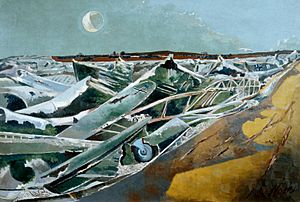
In 1961, art historian Robert Rosenblum compared Friedrich's and Turner's Romantic landscapes to the Abstract Expressionist paintings of Mark Rothko. Rosenblum said that Friedrich's The Monk by the Sea, Turner's The Evening Star, and Rothko's Light, Earth and Blue all show similar feelings. He said that Rothko, like Friedrich and Turner, puts us at the edge of huge, undefined spaces. The tiny monk in Friedrich's painting and the fisher in Turner's show how small humans are compared to God's vast nature. In Rothko's abstract art, these small details are not needed. We ourselves become the monk, standing quietly before these huge, silent pictures.
The modern artist Christiane Pooley also gets ideas from Friedrich's work for her landscapes. She uses them to tell stories about the history of Chile.
What People Thought of His Art
After his friends died, Friedrich's work was almost forgotten for many decades until about 1890. But by 1890, the symbolism in his art started to connect with the art trends of the time, especially in central Europe. Even though people started to appreciate his unique style, his paintings didn't always fit with the art theories of the time.
I am not so weak as to submit to the demands of the age when they go against my convictions. I spin a cocoon around myself; let others do the same. I shall leave it to time to show what will come of it: a brilliant butterfly or maggot.

In the 1930s, Friedrich's art was used by the Nazis to promote their ideas. They tried to make him seem like a nationalistic artist. It took many decades for Friedrich's reputation to recover from this connection. His use of symbols and the fact that his work didn't fit into the new ideas of modernism also made him less popular. In 1949, art historian Kenneth Clark said Friedrich's technique was "frigid" and couldn't inspire modern painting. Clark's negative view showed how much damage Friedrich's reputation had suffered.
Friedrich's reputation was hurt even more when Hollywood directors used his imagery in horror and fantasy movies. His recovery was slow, but critics and scholars like Werner Hofmann helped. They showed that his work was not political and put it back into its proper art history context. By the 1970s, his paintings were being shown in major galleries around the world again. A new generation of critics and art historians started to appreciate him.
Today, Friedrich is well-known around the world. He is a national hero in Germany and highly respected by art experts everywhere. He is seen as a complex artist who believed in beauty but was also haunted by darkness. As William Vaughan said, he "transcends interpretation, reaching across cultures through the compelling appeal of his imagery." He has truly become like a "brilliant butterfly" that we hope will never disappear again.
His Works
Friedrich was a very active artist and created more than 500 known works. He wanted his paintings to be pure expressions of beauty and feeling. So, he was careful not to give them titles that were too detailed or emotional. It's likely that some of the more descriptive titles we use today, like The Stages of Life, were not given by Friedrich himself. He kept a detailed notebook of his paintings, which helps experts figure out when he finished them.
-
Old Heroes' Graves, (1812). This painting shows a ruined monument to Arminius, a German hero. Four open tombs symbolize the spirits of fallen heroes. Two small French soldiers are shown far away in a cave.
See also
 In Spanish: Caspar David Friedrich para niños
In Spanish: Caspar David Friedrich para niños


